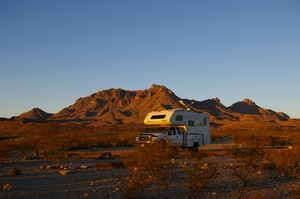 It’s mid January and we’re sitting in a backcountry campsite in
Big Bend
National Park. Off in the hazy
distance, the rugged tops of the Chisos Mountains rise above the nearer
Grapevine Hills while the creosote bushes wave in the chill wind blowing
across this wide, open expanse of desert bathed in the bright winter
sunshine. The outside of the camper is covered in a fine dust blown up
during our seven mile drive out here. There’s no one else nearby and the
quiet beauty of the desert surrounds us.
It’s mid January and we’re sitting in a backcountry campsite in
Big Bend
National Park. Off in the hazy
distance, the rugged tops of the Chisos Mountains rise above the nearer
Grapevine Hills while the creosote bushes wave in the chill wind blowing
across this wide, open expanse of desert bathed in the bright winter
sunshine. The outside of the camper is covered in a fine dust blown up
during our seven mile drive out here. There’s no one else nearby and the
quiet beauty of the desert surrounds us.
When we returned to live in the camper we didn't think of it as
especially small: it's just the size it is. This perception shifted within
a few weeks of being back on the road when Sterling's brother Eric and his
wife Jeanette bought a Class A in preparation for new RV adventures of
their own.
 Seeing the floor plan and the photos had us hankering after
more space and we started searching the internet for something bigger than
our shoebox. Matters were exacerbated by a photograph of Eric
preparing pizza on the kitchen island of their RV. Yes, you read that
correctly, kitchen island! Many hours of scrutinizing and discussing the
options brought us to the realization that we couldn't find anything that
we would prefer sufficiently to spend a great deal of money. We are
content once again and our decision has been confirmed by our ability to
come out to these backcountry sites where the average larger RV cannot.
Seeing the floor plan and the photos had us hankering after
more space and we started searching the internet for something bigger than
our shoebox. Matters were exacerbated by a photograph of Eric
preparing pizza on the kitchen island of their RV. Yes, you read that
correctly, kitchen island! Many hours of scrutinizing and discussing the
options brought us to the realization that we couldn't find anything that
we would prefer sufficiently to spend a great deal of money. We are
content once again and our decision has been confirmed by our ability to
come out to these backcountry sites where the average larger RV cannot.
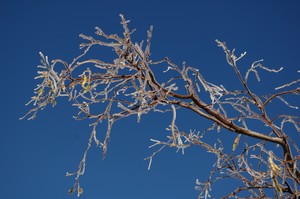 We spent our first nights in the park up in the Chisos
Mountains. Within forty eight hours of arriving the road was closed due to
snow and ice and for two days we were wrapped in freezing mist. As the
skies finally cleared we were rewarded by the sight of the mountains
dusted in snow, glinting in the sun and after being shut up in the camper,
we were eager to get out on one of the trails. Our feet crunched through
the snow on the more sheltered parts of the path and there was a
distinctive sweet spicy smell in the air which we later discovered was the
fragrance given off by Damianita plants in the aftermath of the
precipitation. The views from inside the Chisos Basin are breathtaking:
the steep walls rise precipitously around the large hollow while the
opening of The Window seemingly provides the only obvious escape route.
We spent our first nights in the park up in the Chisos
Mountains. Within forty eight hours of arriving the road was closed due to
snow and ice and for two days we were wrapped in freezing mist. As the
skies finally cleared we were rewarded by the sight of the mountains
dusted in snow, glinting in the sun and after being shut up in the camper,
we were eager to get out on one of the trails. Our feet crunched through
the snow on the more sheltered parts of the path and there was a
distinctive sweet spicy smell in the air which we later discovered was the
fragrance given off by Damianita plants in the aftermath of the
precipitation. The views from inside the Chisos Basin are breathtaking:
the steep walls rise precipitously around the large hollow while the
opening of The Window seemingly provides the only obvious escape route.
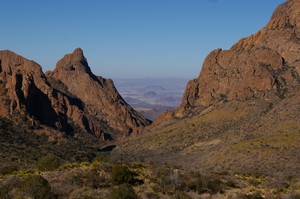 From a distance The Window looks like a wide open U shaped gap
through which the desert floor is visible for many miles. The reality on
closer inspection reveals something very different. The trail winds down
into a small wooded canyon and finally into a much narrower and fairly
tortuous bare rock water course; a place of miniature waterfalls, small
plunge pools and intermittent water flow which disappears before reaching
the narrow drop off down to the desert floor. A short detour up the Oak
Springs Trail presents the wide open vista that we had naively expected
from the famous aperture and we sit contentedly munching our snacks,
gazing off into the distance.
From a distance The Window looks like a wide open U shaped gap
through which the desert floor is visible for many miles. The reality on
closer inspection reveals something very different. The trail winds down
into a small wooded canyon and finally into a much narrower and fairly
tortuous bare rock water course; a place of miniature waterfalls, small
plunge pools and intermittent water flow which disappears before reaching
the narrow drop off down to the desert floor. A short detour up the Oak
Springs Trail presents the wide open vista that we had naively expected
from the famous aperture and we sit contentedly munching our snacks,
gazing off into the distance.
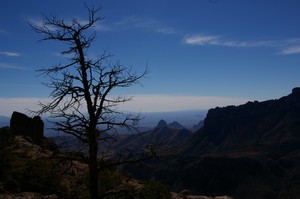 The Lost Mine Trail took us around the base of Casa Grande and
up to a vantage point from where the south rim and it’s various peaks are
visible. This is our favourite trail so far. The path is varied and
moderately challenging, the views spectacular and we’re inordinately
pleased to be out here. The folds and contortions of the landscape are
laid out before us as we reach our destination and sit doing some more
munching and gazing, stilled by the beauty. The quiet is shattered by the
arrival to a pair of raucous ravens flirting with each other and obviously
frisking up for connubials. In an attempt to entice the female, the male
produces a range of sounds like a wooden percussion instrument. She
politely listens to the repertoire, appears quite impressed and takes to
the wind with her suitor mirroring her flight pattern.
The Lost Mine Trail took us around the base of Casa Grande and
up to a vantage point from where the south rim and it’s various peaks are
visible. This is our favourite trail so far. The path is varied and
moderately challenging, the views spectacular and we’re inordinately
pleased to be out here. The folds and contortions of the landscape are
laid out before us as we reach our destination and sit doing some more
munching and gazing, stilled by the beauty. The quiet is shattered by the
arrival to a pair of raucous ravens flirting with each other and obviously
frisking up for connubials. In an attempt to entice the female, the male
produces a range of sounds like a wooden percussion instrument. She
politely listens to the repertoire, appears quite impressed and takes to
the wind with her suitor mirroring her flight pattern.
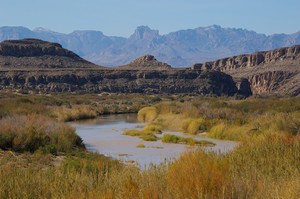 Big Bend is a park of distinct areas and down on the US/Mexico
border the Rio Grande marks the meeting of the two countries. The river’s
name is one of many marriages of Spanish and English and on this side of
the border is pronounced as “Rio Grand” whilst still retaining it’s
original spelling. The interconnectedness of the area was abruptly changed
in 2002 when the US closed the border within the park making the previous
fluid movement illegal.
Big Bend is a park of distinct areas and down on the US/Mexico
border the Rio Grande marks the meeting of the two countries. The river’s
name is one of many marriages of Spanish and English and on this side of
the border is pronounced as “Rio Grand” whilst still retaining it’s
original spelling. The interconnectedness of the area was abruptly changed
in 2002 when the US closed the border within the park making the previous
fluid movement illegal.
The cordial connections with the villages of Boquillas, Santa Elena and San Vicente were broken although the wildfire-fighting crew known as Los Diablos and hailing from the three villages continued to be the park’s chief fire-fighters. Since 2002 they have been the only people permitted to cross the border within the park. The arrangement benefits people on both sides of the border: the park has a highly trained fire-fighting crew in an area that is sparsely populated but susceptible to fire from lightning and careless visitors while the villages have a small amount of desperately needed income.
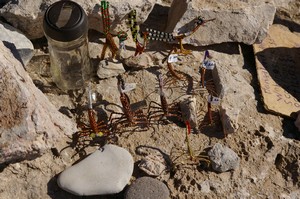 While the border is technically closed there is plenty of evidence to
the contrary in the Rio Grande area. Foot and hoof prints leading down the
banks on both sides of the river re-emerge on the other side while park
service notices warn visitors that it is illegal to buy souvenir items
from Mexican people. Small collections of these souvenirs are to be found
on various trails with written notices offering items for specified
donations, presumably in an attempt to circumnavigate the “Don’t buy from
Mexican Nationals” rule. The fact that there are usually no Mexicans in
evidence may be a further attempt to encourage hesitant customers.
While the border is technically closed there is plenty of evidence to
the contrary in the Rio Grande area. Foot and hoof prints leading down the
banks on both sides of the river re-emerge on the other side while park
service notices warn visitors that it is illegal to buy souvenir items
from Mexican people. Small collections of these souvenirs are to be found
on various trails with written notices offering items for specified
donations, presumably in an attempt to circumnavigate the “Don’t buy from
Mexican Nationals” rule. The fact that there are usually no Mexicans in
evidence may be a further attempt to encourage hesitant customers.
From a vantage point looking over the river we see a saddled horse
patiently waiting for the return of his rider who is carefully
straightening and replenishing a cluster of souvenirs and collecting the
donations from a screw top jar. He repeatedly looks over his shoulder back
along the trail but when he sees us on the rock outcrop high above him
gives us a friendly wave before mounting his horse and making his way to
the river and crossing back over. A few minutes later a tuneful whistling
signals the steady progress of another man on a horse followed closely by
his dog as they ride from the direction of Boquillas on a well worn path
toward the river.
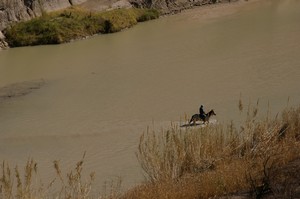 As they enter the water, the whistling changes to
cheerful singing and we watch the nonchalant crossing. There is nothing
clandestine about this and no anxiety evident from the rider. He crosses
into the US, rides across the ground on the inside of the river bend,
re-enters the water and crosses back to Mexico. This is clearly the
established way to avoid the deeper water on the outside of the water
course and a well used track albeit technically illegal.
As they enter the water, the whistling changes to
cheerful singing and we watch the nonchalant crossing. There is nothing
clandestine about this and no anxiety evident from the rider. He crosses
into the US, rides across the ground on the inside of the river bend,
re-enters the water and crosses back to Mexico. This is clearly the
established way to avoid the deeper water on the outside of the water
course and a well used track albeit technically illegal.
Feelings run high in this area when it comes to the border and there are arguments both that the closure of the Big Bend border has caused more problems than there were previously and conversely that there would be more problems if the border was opened again. The federal government has taken the former view and in what appears to be a little publicised move The U.S. Customs and Border Protection issued a rule on the 28th December 2012 declaring the opening of the Boquillas border crossing effective the 28th January 2013. We were planning on leaving the park before then but we may just have to stay to witness this historic development.